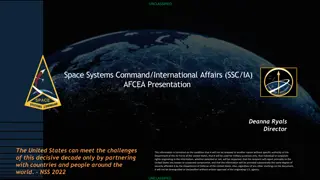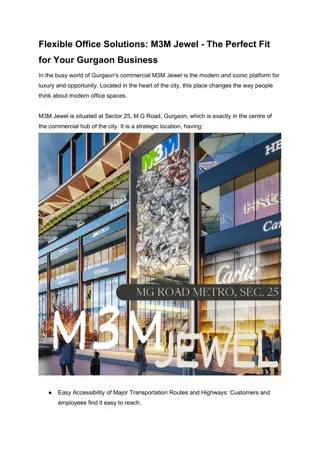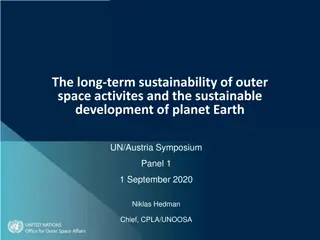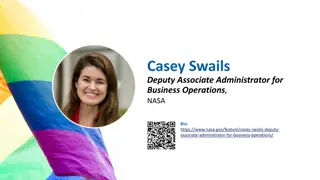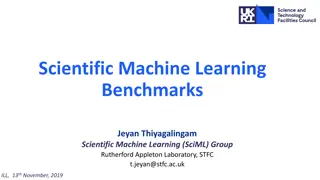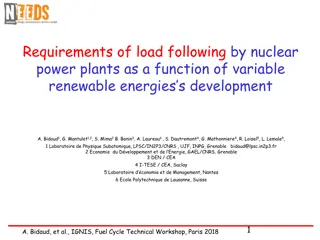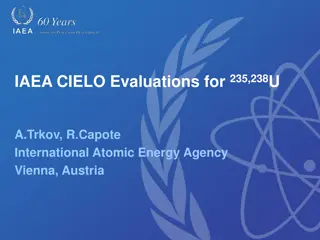S1 Space Unit Benchmarks Overview
By exploring the refraction of light in different materials, lenses, and prisms, understand how light can be used in various applications. Discuss radiations beyond the visible spectrum for selected applications, highlighting advantages and limitations. Engage in communication and note-taking to enhance understanding, analyze texts effectively, and develop informed viewpoints on persuasive techniques. Enhance numeracy skills for data analysis and presentation. Explore careers in physics related to waves. Lessons focus on defining refraction, identifying everyday refraction scenarios, understanding waves as energy-carrying vibrations, and differentiating reflection and refraction in light interactions.
Download Presentation

Please find below an Image/Link to download the presentation.
The content on the website is provided AS IS for your information and personal use only. It may not be sold, licensed, or shared on other websites without obtaining consent from the author.If you encounter any issues during the download, it is possible that the publisher has removed the file from their server.
You are allowed to download the files provided on this website for personal or commercial use, subject to the condition that they are used lawfully. All files are the property of their respective owners.
The content on the website is provided AS IS for your information and personal use only. It may not be sold, licensed, or shared on other websites without obtaining consent from the author.
E N D
Presentation Transcript
S1 Space Unit Benchmarks Overview Science Benchmarks Light and Waves By exploring the refraction of light when passed through different materials, lenses and prisms, I can explain how light can be used in a variety of applications SCN 3-11a By exploring radiations beyond the visible, I can describe a selected application, discussing the advantages and limitations. SCN 3-11b Literacy Benchmarks I am developing confidence when engaging with others within and beyond my place of learning. I can communicate in a clear, expressive way and I am learning to select and organise resources independently. LIT 3-10a I can make notes and organise them to develop my thinking, help retain and recall information, explore issues and create new texts, using my own words as appropriate. LIT 3-15a / LIT 4-15a To show my understanding, I can comment, with evidence, on the content and form of short and extended texts, and respond to literal, inferential and evaluative questions and other types of close reading tasks. ENG 3-17a To help me develop an informed view, I am exploring the techniques used to influence my opinion. I can recognise persuasion and assess the reliability of information and credibility and value of my sources. LIT 3-18a I can persuade, argue, evaluate, explore issues or express an opinion using a clear line of thought, relevant supporting detail and/or evidence. LIT 3-29a Numeracy Benchmarks I can continue to recall number facts quickly and use them accurately when making calculations. MNU 3-03b I can display data in a clear way using a suitable scale, by choosing appropriately from an extended range of tables, charts, diagrams and graphs, making effective use of technology. MTH 2-21a / MTH 3-21a
Power point Icons All the Power points used in the course have the same icons so you know what to expect. The icons used are: Numeracy A note to copy Question/Think point Health and Wellbeing Citizenship Literacy Videoclip
Careers Link! Waves is a Physics Topic optician Light technician Sound engineer Health physics, radiographer
Lesson 1 We are learning to... State what refraction is List some everyday situations that use refraction
Waves What is a wave? A wave is a vibration that carries energy e.g. sunlight. Not these kinds of wave! Waves (3min 48sec) Waves (3min 48sec) More like a Mexican wave!
Light What happens when a wave such as light shines on a mirror? The light reflects, which is known as reflection. What happens when light shines on a see through (transparent) object like a prism or piece of glass?
Refraction The light actually changes speed by slowing down and changes direction inside the prism. The light refracts, which is known as refraction. We do not say the light bends , as light always moves in a straight line.
Refraction Refraction is when light changes speed and direction as it moves into a different material. The light refracts as the different material has a different density which alters the speed and direction of the wave. The same thing happens with other waves such as sound waves, which is why your voice sounds higher in helium!
Why does a pencil look like this in water? REFRACTION Light speeds up going into air (and slows down going into water), making the pencil appear to change direction.
REFRACTION If the fisherman stabs where he sees the fish, he ll miss as the light has been refracted by the water. When do we use refraction in everyday life?
Refraction Refraction is used in many everyday situations such as in: Spectacles/contact lenses Microscopes/telescopes Car headlights Refraction (4min 36sec) Refraction (4min 36sec)
Lesson 1 You should be able to State what refraction is List some everyday situations that use refraction
Lesson 2 We are learning to... Draw a convex lens and a concave lens Explain what a convex lens and a concave lens do to light rays
Lenses What is a lens? A lens is a transparent device that is used to refract light. This can be useful in focusing light such as in the eye. Lenses can be used to focus light and see objects clearly such as in microscopes, telescopes, contact lenses and glasses.
Lenses There are two types of lens: (1) Convex (2) Concave Both types of lens refract light but in different ways. Light travels in a straight line until it is refracted by the lens.
Lenses The simplest of telescopes consists of 2 convex lenses positioned in a long cylindrical tube. Convex lens (eyepiece) Convex lens (objective)
Lenses A lens is a device that is used to refract light. This can be used to focus light to see things clearer. There are two types of lens convex and concave. Task: Collect a raybox, lenses, paper and a pencil. In a dark room, investigate what happens when light is refracted through a convex and a concave lens.
Lenses Result: The convex lens brings all the beams of light to a focus. This is known as converging. Focus
Lenses Result: The concave lens makes all the beams of light spread out. This is known as diverging.
Lenses Task: Collect the lenses diagram and glue into your jotter. Label the diagram to show which is the convex lens and which is the concave lens. Convex Concave
Lenses Imagine looking at a basket of peanuts. Some people see picture A and others picture B why do glasses not make the image clearer for everyone? A B
Lenses The lens of our eyes have a unique shape. If the object doesn t focus on the back of the eye (the retina) then the object will be blurry. A lens in front of the eye helps to focus light.
Go to : Pupil Share> Physics> Flash Learning> Physics Animations> > Optics and relativity> Sight-Normal, long, short for animation about how these lenses work
Lenses Thicker lenses refract the light more and the focus is then closer to the lens.
Lesson 2 We are learning to... Draw a convex lens and a concave lens Explain what a convex lens and a concave lens do to light rays
Lesson 3 We are learning to... Explain how a visible spectrum is produced as light passes through a prism List the order of the main colours that make up the visible spectrum
Visible spectrum What is the visible spectrum? The visible spectrum is basically light that we can see. Although light looks white to us, it is in fact made of a variety (spectrum) of 7 colours. These 7 colours become obvious when light is refracted through a triangular prism. Raindrops act as natural prisms and refract light into a well known pattern
Visible spectrum A rainbow shows the 7 colours of light that are known as the visible spectrum.
Task 1 : - Collect a ray box - Connect to power supply - Shine fine beam of light through triangular prism as shown below ( should be equilateral triangle) - Observe results on white paper screen
-Collect your colour spectrum diagram and stick in jotter -Complete your diagram with colour pencils
Visible spectrum All the colours are refracted differently e.g. red light is refracted the least. This explains why the blue region (which is most refracted) is the main colour of the sky at midday, but often red at sunrise or sunset as the red light is refracted over the horizon. Visible spectrum (4min 7sec) Visible spectrum (4min 7sec)
Visible spectrum The visible spectrum is the light we can see. The visible spectrum is produced when light passes through a prism as some colours refract more than others. The colours that make up the visible spectrum are:
Task 2 : Using the first letters of the colours of the visible spectrum, make a mnemonic ( your teacher will explain) of the letters to remember the order of the colours easily
Lesson 3 We are learning to... Explain how a visible spectrum is produced as light passes through a prism List the order of the main colours that make up the visible spectrum
Lesson 4 We are learning to... Describe what the electro-magnetic spectrum (EMS) is Give examples of types of waves (and their uses) in the EMS Use the internet to search for information Work as a team to produce a research poster
Electro-Magnetic Spectrum (EMS) Visible light is one member of a family of waves known as the electro-magnetic spectrum (or EMS for short). All the waves move at the same speed (the speed of light = 300,000,000 metres per second!). The other waves are not visible, but all behave the same way as light e.g. they can be reflected and refracted.
Electro-Magnetic Spectrum (EMS) X-rays Radio & TV waves Infrared waves Ultraviolet waves Microwaves Gamma rays
Gamma X-Rays Ultraviolet Visible Light Infrared Microwaves TV/Radio Violet short waves Red long waves
Electro-Magnetic Spectrum (EMS) The electro-magnetic spectrum (EMS) is a family of waves that can all move at the speed of light. As well as visible light, there are 6 other types of waves in the EMS: Task: Collect the EMS waves diagram and complete.
Electro-Magnetic Spectrum (EMS) Task: Add microwaves to your table with a suitable description e.g. Used for cooking and in mobile phone communication Ultra violet rays Visible light Gamma rays Infra-red rays X-rays Radio waves
Electro-Magnetic Spectrum (EMS) Task: Working as part of a group, you will now do an internet research task on one wave from the EMS. Once you have researched the wave, its wavelength, its uses and some interesting facts, make a colourful, informative poster to teach the rest of the class about your part of the EMS. We will then peer assess each others posters.
Microwaves Radio & TV waves Infrared waves Ultraviolet waves X-rays Gamma rays Visible Light
Peer Assessment There are 3 sections to the peer assessment form:
Summary of EM spectrum Radio Carries; Information (Internet) News Music
Microwave Used for Cooking Mobile Phones Radar Satellite communication



![Read⚡ebook✔[PDF] Linking the Space Shuttle and Space Stations: Early Docking Te](/thumb/21519/read-ebook-pdf-linking-the-space-shuttle-and-space-stations-early-docking-te.jpg)
![READ⚡[PDF]✔ Emerging Space Powers: The New Space Programs of Asia, the Middle Ea](/thumb/21554/read-pdf-emerging-space-powers-the-new-space-programs-of-asia-the-middle-ea.jpg)


